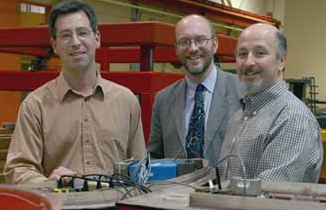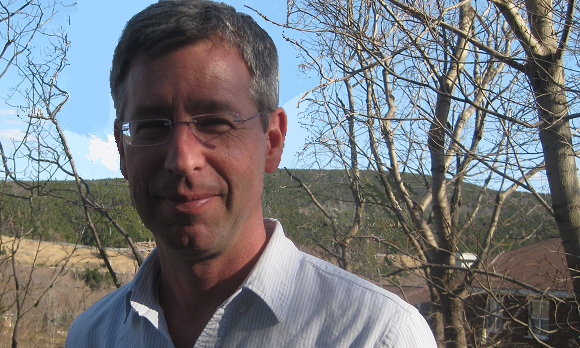AS THE JET LIFTED OFF FROM THE HELSINKI RUNWAY AND VEERED WESTWARD IT CARRIED among its passengers the newly minted Dr. Brian Veitch. With him he brought a dedication to creativity in science and research, an eagerness to overcome challenges, and an as yet unrealized drive to make an impact on safety at sea. It was late December of 1995 when the St. John’s born engineer and naval architect arrived home, a time of year when it would be understandable for someone in his position to relax for a few weeks. Not Brian Veitch. Within days he had made the transition from solitary directed research in Finland to team-based research at the NRC’s Institute of Marine Dynamics (IMD) in St. John’s.
Today as Husky Energy Chair in Oil and Gas Research, Veitch helps develop engineering capabilities for harsh environment operations. During his academic career, which began in 1998, he’s developed an applied research program on ocean environmental risk engineering and initiated an inter-disciplinary research program on offshore and maritime safety. His goal is simple: Improve safety at sea. He has been recognized internationally for his work and has won several awards, including the President’s Award for Outstanding Research at Memorial University and Transport Canada’s Marine Safety Award. He also helped launch several technology companies with his graduate students.
Reflecting on his life’s work thus far, Veitch traces it back to a mid-February morning in 1982 after a vicious overnight storm. He was shovelling his grandmother’s driveway when she came out with news that the Ocean Ranger Oil rig had gone down and all hands were lost.
But Veitch says that tragedy did not influence his choices at university that fall. “In high school I was interested in everything and anything. At MUN I just wanted something that was challenging and interesting,” he admits. “And for me, that was engineering—the practicality of science and the potential for creativity.”
Naval architecture proved the most interesting discipline for Veitch. “At the age of 18, I spent my first work term in the naval dockyard in Halifax working on everything from destroyers to tugs to submarines. That pretty well cemented my conviction,” he admits. On subsequent work terms he was assigned to the Bedford Institute and then two shipyards in Finland.

Veitch’s first work-term at the naval ship yard in Halifax cemented his interest in naval architecture.
After his undergraduate degree he transitioned directly into Memorial’s Master’s program under Dr. Neil Bose, an award winning researcher and Canada Research Chair in Offshore and Underwater Vehicles Design.
By 1991 he’d entered graduate studies at Helsinki University of Technology, graduating in 1995 with his Doctor of Science in Technology. His laboratory work there involved testing ice loading on the innovative Azipod propellers. “Someone in one of the shipyards had a really good idea for ship propulsion and spent a lot of time in that investigation. Even though I had a limited role in advancing the technology, that was my first involvement in innovation change,” says Veitch. But not his last.
Upon his return to St. John’s Veitch was keen to start at IMD. “As a junior researcher I could incorporate others into the things I wanted to do—call on technical people to do things better and faster than me,” he says, “and the facilities are fantastic.”
Then in 1998 he was hauled into the world of academia. Veitch credits his former supervisor Bose and industry insider Greg Lever for one of the most significant steps in his career. Memorial University was recruiting for the junior research chair for the Terra Nova Project. “The position wasn’t in my area. Neil convinced me to apply.” Veitch made the short list. He recalls the next step as a gruelling two-day process. “After the first day I decided I didn’t want it,” he admits, because he was put off by the academic interview. “I went back for the second day, but I didn’t think it was going to end well. “
That day a conversation over lunch with Greg Lever convinced him to keep his hat in the ring. Lever was Petro-Canada’s general manager for Newfoundland and Labrador, leading the offshore Terra Nova project through the regulatory approval process and project sanction. “Greg told me there was a lot of freedom in the position. He said I could accomplish important things that I was interested in doing,” recalls Veitch. “I took the job largely based on the way Greg described it” admits Veitch who served in two consecutive five year terms.
Given this freedom to follow his instincts, his deeper motivations began to emerge. “When the Ocean Ranger sank it had a visceral impact on me,” says Veitch. “I decided in addition to studying risks to the environment, I would also revert back to my naval architecture and maritime safety.” And so he began to build a team.
Among the people he wanted on the team was Antonio Simões Ré, the NRC’s Senior Research Engineer, whom Veitch knew was focused on practical research and development related to safety. “Antonio and I have complementary skills. With me at Memorial University and him at NRC we had access to a wider range of programs for funding and research,” he says.
whom Veitch knew was focused on practical research and development related to safety. “Antonio and I have complementary skills. With me at Memorial University and him at NRC we had access to a wider range of programs for funding and research,” he says.
Front Row: Veitch with Antonio Simões Ré and (Back Row) Captain Tony Patterson
And they were both motivated by the same goal: to have an impact on safety. “For Antonio and me it was essential that we have impact or our efforts would have failed.” But as scientists and engineers, they weren’t sure of how best to share their knowledge with the world.
“We published and made presentations and even tried patenting to get our work out in the world,” says Veitch, but the uptake wasn’t enough. “Then we participated in developing international standards and that was like watching grass grow, but it was impactful,” says Veitch. They’d found a route that worked but the time and the effort involved were hard to justify.
Then, by chance in the early 2000s, Veitch discovered a more effective route to impact maritime safety. Among his graduate students was Dean Pelly. Here was a person with confidence that his innovation—based on work he did with Veitch and his team—presented a business opportunity. “This decision [to start a business] had a profound impact on him. It changed Dean’s life,” says Veitch. “His company had a good product that would improve safety at sea and he had a number of successes before his company was acquired.”
Pelly’s success and the uptake of his innovation convinced Veitch that commercialization was a great route to impact. “We were aware of commercialization of course, but we hadn’t gotten that close to it before. Seeing the power of the process first hand, I made it part of what I do. But this isn’t for everyone,” he admits.
“It is rare, but occasionally a graduate student comes along who’s interested in the entrepreneurial journey,” says Veitch. “Each time it happens I make a vow to support them until they outgrow me.”
Instead of using academic or regulatory channels to introduce innovative ideas that could have a positive impact on maritime safety, Veitch began to seek ways to connect those ideas to graduate students like Pelly, and Randy Billard of VMT Inc. “We co-founded VMT to deliver virtual marine training to help save lives at sea. More recently there was Peter Gifford with Extreme Ocean Innovation.”
Veitch appreciates his role as the university guy, matching good ideas with the right people. “A university cannot do its own commercialization,” he explains. “We need people who will dedicate their lives to this. It is a tough and long haul and I don’t try to convince anyone to do it. The people with the right mix [of innovation and entrepreneurial drive] only come along every once in a while. They must be innovative, risk tolerant, and professional. Whether or not the business succeeds, it’s a good training ground for knowledge you can’t get any other way.”
—30—

